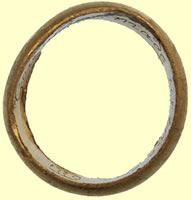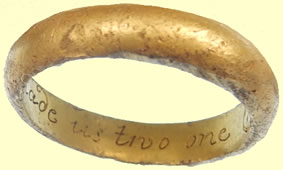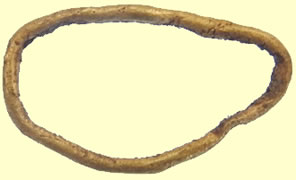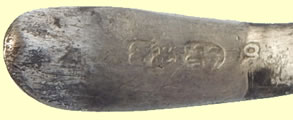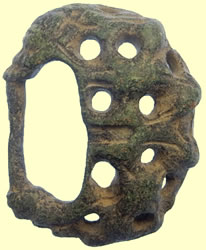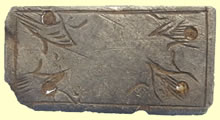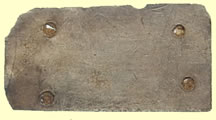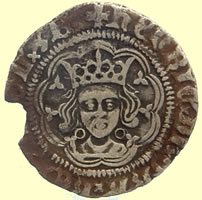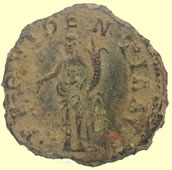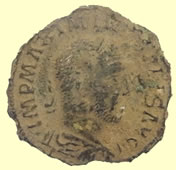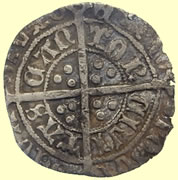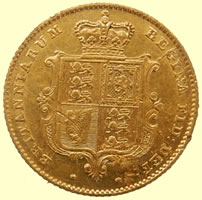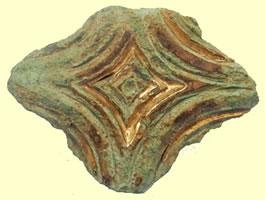

Metal detecting holidays in England with the World's most successful metal detecting club.
Twinned with Midwest Historical Research Society USA
1351-2 Edward III hammered silver groat - Type F Obv EDWARD D G REX ANGL Z FRANC D HYB Rev POSVI DEVM ADIVTORE MEVM (outer) CIVITAS LONDON (Mint) (inner) |
|||
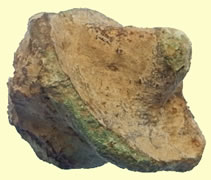 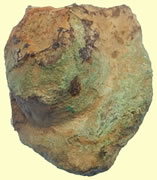 |
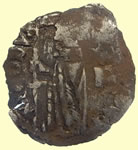 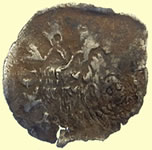 |
||
| Roman bronze mount | Italian States-Venice, Antonio Venier as Doge (1382-1400), Soldino, Venice Mint + . ANTO. VE_NERIO DVX . Doge standing left, holding banner, R across fields + . S . MARCVS . VENETI . Winged lion of St. Mark facing left, holding book with both front paws, all in inner circle Plain Edge |
||
 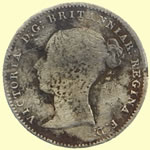 |
  |
||
| 1864 Victoria milled silver sixpence | 1205 William 1 The Lion - Scottish hammered silver penny Obv WILAM Rev HUE WALTER Moneyer Walter of Perth, Edinburgh and Roxburgh mints |
||
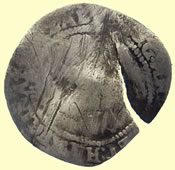  |
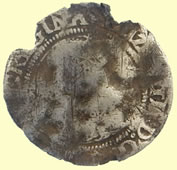  |
||
| 1580-1581 Elizabeth 1st hammered silver three pence - Greek cross mint mark | 16thC Elizabeth 1st hammered silver three pence | ||
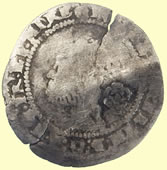 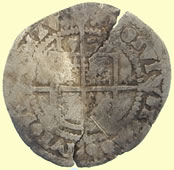 |
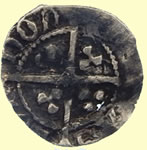  |
||
| 1573 Elizabeth 1st hammered silver three pence- Eglantine mint mark | 1464-70 Edward IV hammered silver half penny- Light coinage Obv EDWARD DI GRA REX Rev CIVI/TAS/LOND/DON - London mint 13.13mm, 0.34g |
||
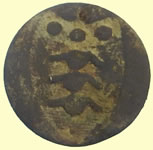 |
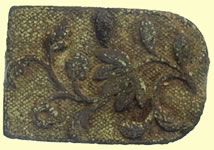 |
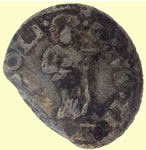 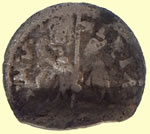 |
|
| 18THc Royal Artillery button | 18thC clog fastener | 1501-1521 Leonardo Lauredan, Doge Rev: LAVS TIBI SOLI (Thee Alone be Praised). Haloed figure of Christ holding a cross. Obv: LE LAV DVX S M V (Leonardo Lauredan, Doge. St Mark of Venice.) Doge kneeling before Saint Mark. |
|
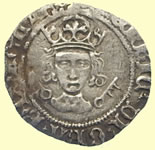 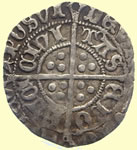 |
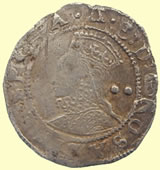 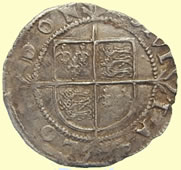 |
||
1485 - 1509 Henry VII hammered silver half groat - Archb Savage Keys by neck Obv HENRIC DI GRAxREXxANGL Rev CIVI/TAS/EBO/RACI - York mint |
1582-84 Elizabeth 1st hammered silver half groat - A mint mark | ||
 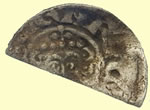 |
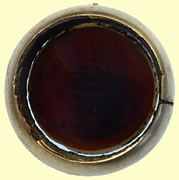  |
||
1216 Henry III hammered silver short cross half penny Rev AN+SAM - Moneyer Samvel of Canterbury mint |
Georgian fob chain gold plated stone decorative swivel | ||
 |
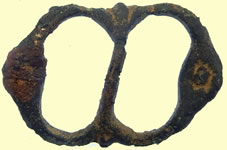 |
 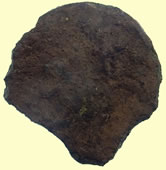 |
|
| Medieval buckle | 1500-1650 buckle | 4thC Roman bronze 'galley' coin | |
Medieval decorated buckle plate |
|||
 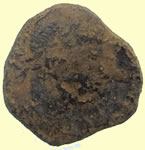 |
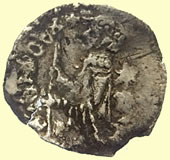 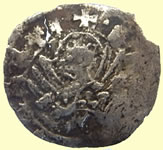 |
||
| Mid 4thC House of Constantine Roman bronze coin - two soldiers standing | Doge Michele Steno (1400-1413).
|
||
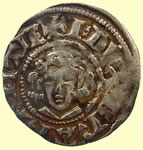 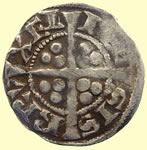 |
|||
13thC hammered silver sterling imitation Crockard - Chaplet of roses to crown Medieval hammered silver penny - Continental imitation , E(a) Sterling type Obv + IDVX BRABANTIE Rev SIS/RRV/XEI/IEE |
|||
 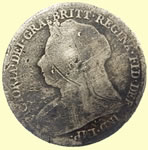 |
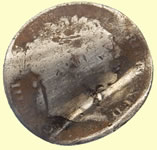 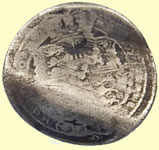 |
||
| 1895 Victoria milled silver sixpence | 1816 George III milled silver love token This is the latest date love token coin I have seen |
||
Fascinating relic - 1901 - 1910 Edward VII pendant with young Edward and wife on one side and old Edward on other side |
|||
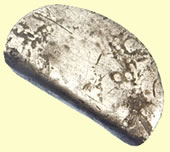 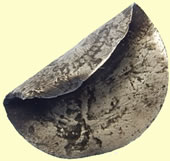 |
 |
||
| 16thC Elizabeth 1st hammered silver half groat | 1600 - 1720 buckle | ||
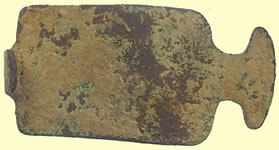 |
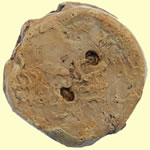 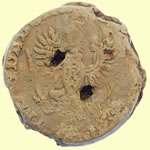 |
||
| 18thC clog fastener | Post medieval German lead bale seal | ||
 |
 |
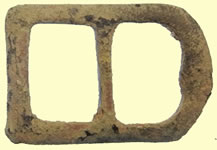 |
|
| 19thC liver button | North Eastern Railways button | 1550 - 1650 buckle | |
 |
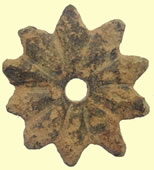 |
 |
|
| Georgian silver thimble | Medieval spur rowel | 1500 - 1650 buckle | |
1800 George III gold third guinea
|
|||
  |
 |
||
| Victorian solid silver case lid | 1500-1700 mount | 20thC British Railways button | |
 |
 |
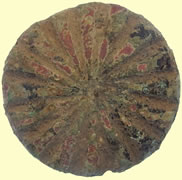 |
|
| 1500-1700 mount | 20thC Colchester transport button | 1500-1700 mount | |
Huge 8.5cm long medieval bronze key
10- 40 AD Cunobelin Celtic gold qtr stater - sent to PAS for recording 1.33g, 11.57mm
45 BC to 25BC Addedomarus - Trinovantian tribe Celtic gold qtr stater - sent to PAS for recording 1.34g, 12.34mm
Simply stunning chunky early medieval gold decorated bronze cross pendant - The gold pin decoration is very interesting as it probably riveted a central inlaid emblem which is now missing- one for the museum to play with 18.76g, 41.18 mm L x 6.73 mm T
|
|||
Saxon silver penny fragment sent to Fitzwilliam for recording and ID - reported as hoard to museum |
|||
 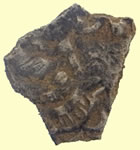 |
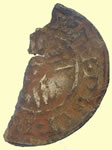  |
||
| Saxon silver penny fragment sent to Fitzwilliam for recording and ID - reported as hoard to museum | Saxon silver penny sent to Fitzwilliam for recording and ID - reported as hoard to museum This is probably a 1016 AD Cnut Short Cross type |
||
| These three new fragments and the Cnut Short Cross fragment reported in 2014 seem to be from four separate coins. The largest new fragment reads +PVLFP[ ], which is the beginning of numerous moneyers' names in the Short Cross type, and the surviving portion of the moneyer's name on the the other fragment with a visible inscription - [ ]FPO[ ] - is equally ambiguous. Best wishes, Martin |
|||
 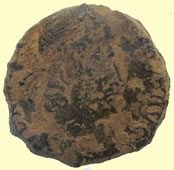 |
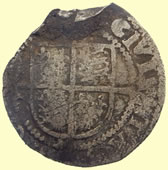  |
||
4thC Roman bronze coin sent for ID Your first piece is a "garden variety" Constantius II, 337-361, reduced Æ majorina, c. 350-355, FEL TEMP REPARATIO Soldier lunging left spearing fallen horseman. I can't read the exergual mint mark, but these were struck at all the official Imperial mints and probably dozens of unofficial mints here and there throughout the Empire. Mark Lehman
|
16thC Elizabeth 1st hammered silver half groat | ||
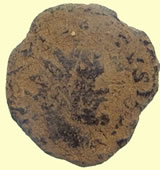  |
 |
 |
|
4thC Roman bronze coin sent for ID And your coin # 2 is a billon "Quinarius" (presumably 1/2 antoninianus) of Allectus - the far less successful successor to Carausius, 293-296. Mark |
15thC lead token - type 2 | 1550 - 1650 buckle | |
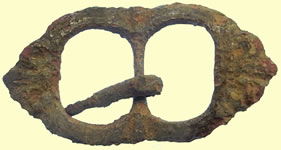 |
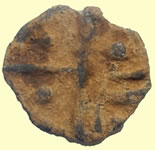 |
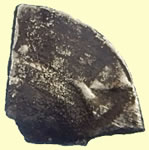 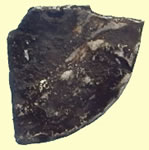 |
|
| 1550 - 1650 buckle | 15thC lead token - type 2 | Medieval hammered silver farthing | |
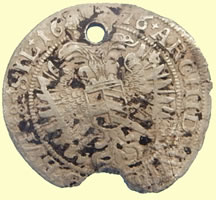 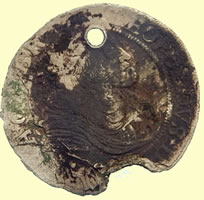 |
 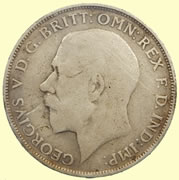 |
||
1676 billion silver coin XV Kreuzer (15 Kreuzer) Breslau 1676 MMW RDR Leopold I.Austria, Leopold I (Hogmouth) Obv LEOPOLDVS DG RI SAG H B REX Rev 1676 ARCH ID AVS BVR 82 SIL |
1922 George V milled silver florin (24 pence) | ||
  |
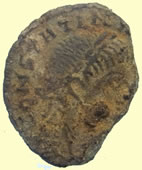 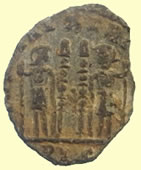 |
||
| 1565 Elizabeth 1st hammered silver sixpence | 4thC Constantine Roman bronze coin - two soldiers standing | ||
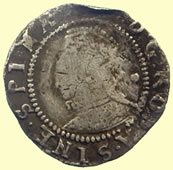  |
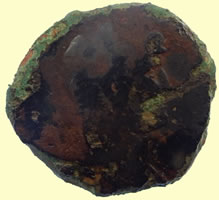 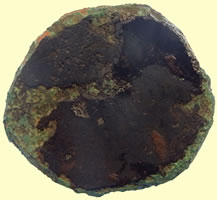 |
||
| 1582- 1584 Elizabeth 1st hammered silver half groat- A mint mark | 2ndC Roman bronze sestertius coin | ||
 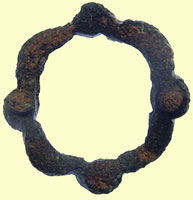 |
 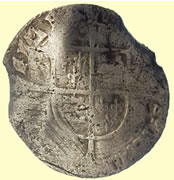 |
||
| Medieval annular brooch with enamel inlays | 1553 Mary hammered silver groat | ||
 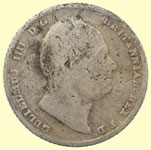 |
  |
||
| 1835 William IV milled silver sixpence | Post medieval trade weight | ||
First double bust type 2ndC Roman silver I have seen - sent to mark Lehman for an ID Very interesting - this is Marcus Antonius - Marc Antony - and Octavian (later to be Augustus) - an issue from Ephesus in the spring-summer of 41 BC - before the two of them had fallen out and while they were two legs of the triumvirate - along with Pompey. Obv: M ANT IMP AVG III VIR R P C M BARBAT Q P (MP & AV are ligate) Bare head of Marc Antony right. This is a HIGHLY desirable coin in almost any condition, but this is in pretty good shape. The "granular" area, I'm afraid, looks a lot like a shovel-mark - but that's one of the almost unavoidable risks of MD (or really, any) digging style. I would advise the owner to seek professional conservation - or to leave it completely as-found until some sophisticated and professional cleaning techniques can be brought to bear. Mark You may hear talk about the "historicity" of a coin - this one is from quite near "ground zero" for the true beginning of the Roman Empire as we know it. My congratulations to the digger. It might not have the market potential of an aureus, but it's an important historical document nonetheless. Mark
|
|||
  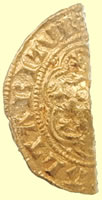 |
|||
1361 Edward III hammered gold 1/4 noble Edward III (1361), Quarter-Noble, Transitional Treaty Period, quartered shield of arms - need to be straightened for definitive ID lions in angles, lis above lion in fourth quarter, within beaded and linear tressures of eight arcs, trefoils in spandrels, beaded circle surrounding, saltire stops in legend, +exaltabitvr: in: gloria 19.91mm,1.96g |
|||
Ancient gold slag nuggets probably Saxon period- a previous larger example we found was disclaimed by the British museum as undiagnostic. The previous finder melted down the slag and made two gold cross neck laces, one was presented to landowner, Sent to local and Fizwilliam museum for their comments 10.15g, 21.06mm L
10.22g, 22.55mm L
16.72g, 36.43mm L
17.15g, 30.60mm L
|
|||
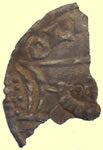 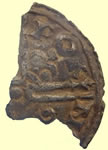 |
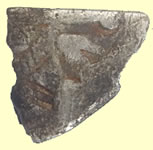 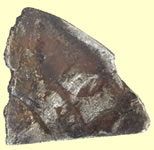 |
||
| Saxon silver penny fragment sent to Fitzwilliam for recording and ID - reported as hoard to museum | Medieval hammered silver farthing | ||
  |
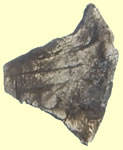  |
||
1199 King John hammered silver short cross penny - Class 5a-5b Obv RICVS R ** Rev ICE+RA - Moneyer Ravlf of Chichester mint |
1247 Henry III hammered silver voided long cross farthing | ||
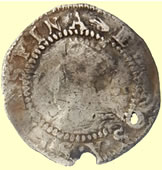 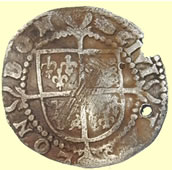 |
 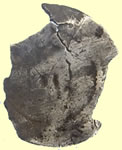 |
||
| 1590 -1592 Elizabeth 1st hammered silver half groat - Hand mint mark | Medieval hammered silver long cross penny | ||
 |
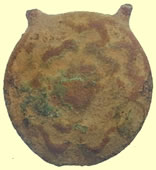 |
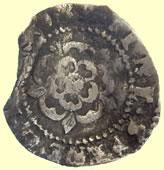 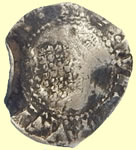 |
|
| 19thC livery button | 16thC Tudor clothing fastener | 1603 James 1st hammered silver penny | |
  |
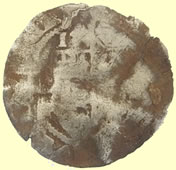  |
||
1247 Henry III hammered silver voided long cross penny Obv hENR ** Rev hEN/RIO - Moneyer Henri |
16thC Elizabeth 1st hammered silver three pence | ||
  |
 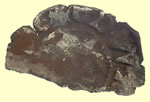 |
||
| Medieval hammered silver long cross farthing | 1327 Edward III hammered silver half penny Obv + EDWA** Rev TAS/LON - London mint |
||
  |
  |
||
| 1216 Henry III hammered silver short cross farthing | 1216 Henry III hammered silver short cross half penny Obv hEN*** X Rev NICOL * - Moneyer Nicole |
||
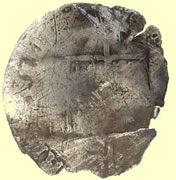 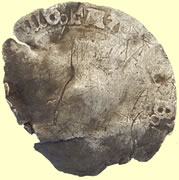 |
 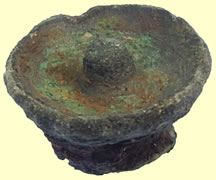 |
||
| 1553 Mary hammered silver groat | Roman bronze mount | ||
10- 40 AD Cunobelin Celtic gold qtr stater - sent to PAS for recording 1.31g, 11.16 mm
|
|||
Medieval Papal Bullae. A lead Papal Bullae of Pope Obverse shows the heads of the apostles Peter and Paul, the founders of the Church of Rome with SPASPE (Sanctus PAulus and Sanctus PEtrus) above Rev ELIE STMVS PI III http://historymedren.about.com/library/who/blwwpopelist.htm 38.73mm, 44.13g http://www.newadvent.org/cathen/12272b.htm So far I cannot find the pope's name on the complete popes list links above ?? The reverse (verso) of the bulla shows the name of the Pope, which is written in the nominative, with his abbreviated title. It reads 'CELE / STINVS / PP • III' within a beaded border. The 'PP' has an 'Ω' above. This bulla has the name of Pope Celestine III on the verso. He was elected Pope in 1191 and continued until 1198. |
|||
Spectacular find c 10th C Late Saxon stirrup mount - Class 4 Type 10B - Traces of original silvering with decoration around top and edges remain This classification comprises most of the mounts reflecting the Urnes style influences and depicting coiled animals. Similar design Ref 190 Page 55 Williams - The curving neck of the beast seems to terminate in a head with a beak. |
|||
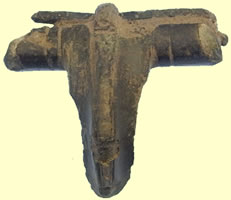 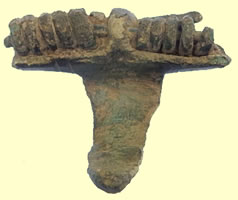 |
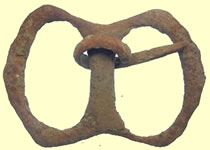 |
 |
|
| 2ndC Roman fibular brooch | 1500 - 1650 buckle | Medieval buckle | |
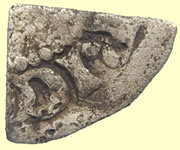 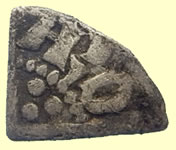 |
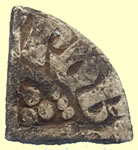 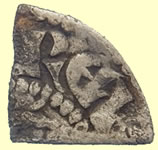 |
||
1247 Henry III hammered silver voided long cross farthing Obv ** RIC ** Rev ARD - Moneyer Ricard |
1247 Henry III hammered silver voided long cross farthing Obv **REX ** Rev ** ROB** - Moneyer Roberd or Robert
|
||
  |
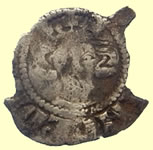 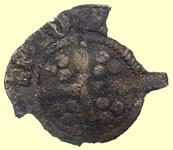 |
||
1180 -1189 Henry II hammered silver short cross half penny - Class 1 Obv X hENR *** Rev OR + REIN - Moneyer Reinald of Northampton mint |
1279 Edward 1st hammered silver penny | ||
  |
 |
 |
|
1247 Henry III hammered silver voided long cross half penny - Class 5 Obv **RICVS RE ** Rev /VND/REN - Moneyer Renavd of Burt St Edmunds mint |
1500-1650 buckle | 19thC hunting button | |
 |
 |
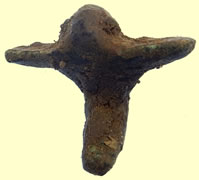 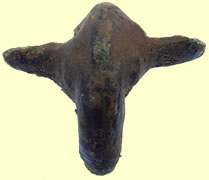 |
|
| 1500-1700 mount | 1500-1700 mount | 2ndC Roman fibular brooch | |
 |
 |
 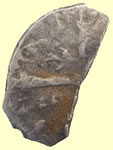 |
|
| 1795 Royal Artillery button | Roman mount | 1279 Edward 1st hammered silver halfpenny Obv ** RDVS REX |
|
  |
 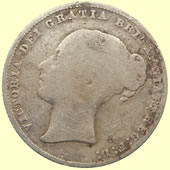 |
||
| Unknown Roman widget with suspension loop ? | 1867 Victoria milled silver sixpence | ||
1560 - 1561 Elizabeth 1st hammered silver shilling (12 pence) Cross Crosslet mint mark |
|||
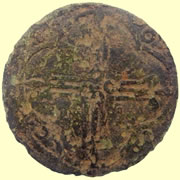 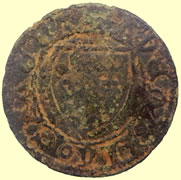 |
 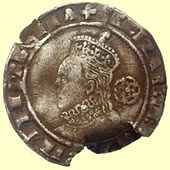 |
||
15thC 'Shield of France' Jetton Obv X AVE MARIA o GRACIA |
1578 Elizabeth 1st hammered silver half groat - Greek cross mint mark | ||
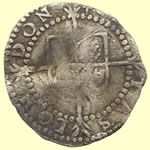 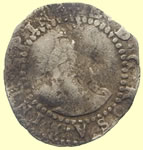 |
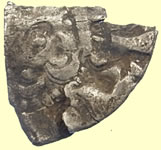 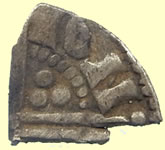 |
||
| 1578 - 9 Elizabeth 1st hammered silver penny - Greek cross mint mark | 1247 Henry III hammered silver voided long cross farthing | ||
 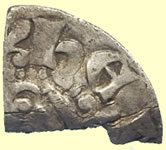 |
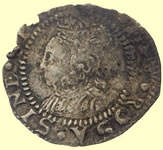 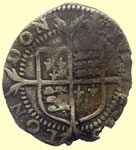 |
||
| 1247 Henry III hammered silver voided long cross farthing | 1560 - 1561 Elizabeth 1st hammered silver penny -Cross Crosslet mint mark | ||
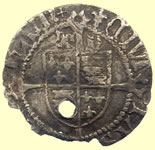 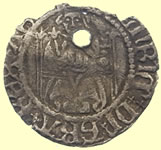 |
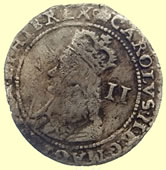 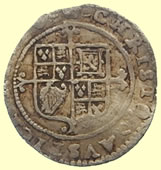 |
||
1526-44 Henry VIII hammered silver sovereign penny - TC above shield Obv CIVI TAS EBO RACI - York mint |
1635 -6 Charles 1st hammered silver half groat - Crown mint mark | ||
 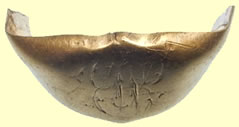 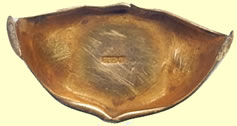 |
|||
| Victorian gold signet ring | |||
 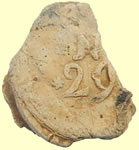 |
  |
||
| 1760 Russian bale seal | Gold plated Victorian watch winder | ||
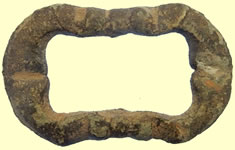 |
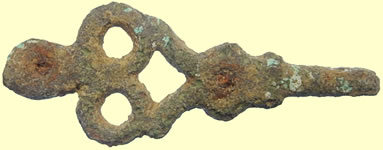 |
||
| 1550 - 1700 buckle | Medieval book clasp | ||
10-40 AD Cunobelin Celtic silver unit Sitting Griffin type - CVNO in tablet, wreath border Griffin right on tablet containing CAMV - Classed as Extremely Rare VA2051 1.25g, 14.29mm |
|||
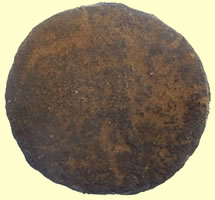 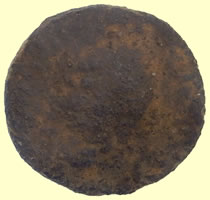 |
 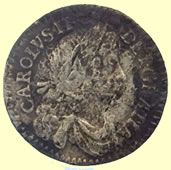 |
||
| Roman silver coin - needs a good cook to remove horn silver crust | 1677 Charles II milled silver two pence | ||
Primary Saxon silver sceat 600- 700 AD - 'cooking' it to clean off crust Sent to Fitzwilliam museum for recording 1.27g, 12mm Many thanks for this new find, which I have recorded as EMC 2015.0132. |
|||
  |
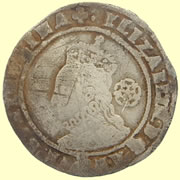  |
||
Continental milled silver LOUIS XV "THE WELL-BELOVED" Écu dit "aux branches d'olivier" 1738 Tours silver |
1578 - 9 Elizabeth 1st hammered silver six pence- Greek cross mint mark | ||
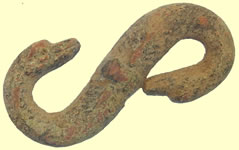 |
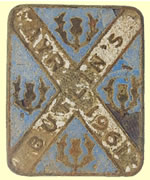 |
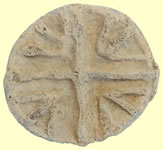 |
|
| 16thC Tudor S buckle | 1961 Butlins enamelled badge Ayr in Scotland |
15thC lead token | |
Superb 1500 -1700 fish design belt slide |
|||
Huge Roman bronze sent for ID 29.27mm, 13.09g Yes, it's a pretty easy one to pin down as to the emperor - I love it when we have nice, clear obverse legends I believe this is a smallish bronze sestertius rather an an as, at this weight. This is Gordian III, a young emperor (ascended at the age of 13 or so, I believe) who ruled for a relatively long time towards the beginning of the social, political and economic chaos of the 3rd century. He ruled from 238-244 - from the time of the defeat of his uncle and grandfather, Gordians I & II until he was deposed by the Praetorian prefect Philip (I, "The Arab") The sestertius, which had previously primarily been struck in "orichalcum" brass had by this time become a fully bronze piece. The obverse legend on this is IMP GORDIANVS PIVS FEL AVG. Gordian was given the title "Pius" (faithful) due to his significant efforts to punish the legion responsible for the downfall and death of his uncle and gandfather. http://www.stoa.org/gallery/album100/ML_23_Gord_III_Sol_as This piece, at 9.09g, is just about right at average for an As - yours at 12+g must have been a sestertius since dupondii invariably had the ruler wearing the radiate crown. Not a bad find, considering how profoundly chipped and deteriorated a lot of the Æ you've been finding lately seems to be - this isn't nearly so bad as some. Mark |
|||
  |
  |
||
| 1866 Victoria milled silver sixpence | 1485 -1509 Henry VII hammered silver sovereign penny - RD by shield Throne has one pillar Bishop Fox - Durham mint
|
||
Very interesting Roman bronze mount - could be a face |
|||
Medieval badges Ref Mitchiner p244 939 - 941
|
|||
 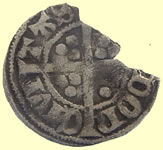 |
 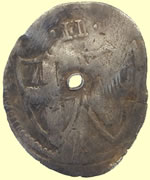 |
||
1377-1399 Richard II hammered silver half penny Rev **D REX x ANGL'+ Obv CIVI/TAS/***/DON = London mint |
1649 Commonwealth hammered silver half groat | ||
  |
  |
||
| 1816 George III milled silver shilling | 1931 George V milled silver sixpence | ||
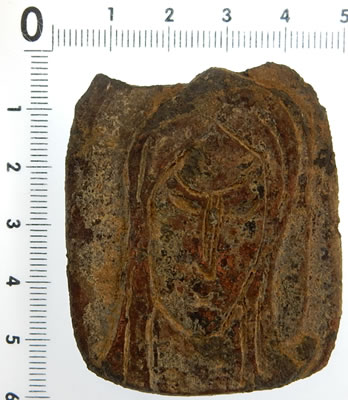 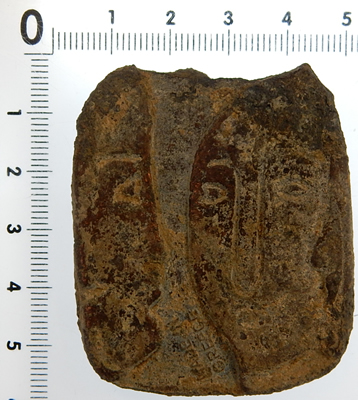 |
|||
| This amazing huge copper relic, that I though initially was a monster medieval religious find, turns out not to be as it appears . When I blew up the photo I noticed a MADE IN GREECE mark next to the double bust- This had me completely fooled. Still a neat find but not a 1000 years old LOL | |||
Staggeringly beautiful 16thC Tudor gold key brooch - reported as treasure to museum 1.80g, 36mm L |
|||
Heavy thick 17th/18thC gold posy ring with inscription - reported as treasure to museum 'God alone made us tivo one' ( God made us to two be one ?) Maker RD 7.51g, 22.68mm |
|||
Medieval high carat small gold band - possible child's ring 12.56mm, 0.16g |
|||
  |
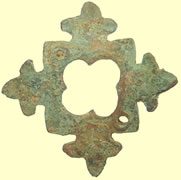 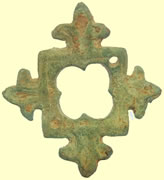 |
||
1279 Edward 1st hammered silver penny Obv +EDWAR ANGLE DNS hYB Rev CIVI/TAS/CAN/TOR - Canterbury mint |
Medieval mount | ||
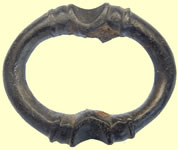 |
 |
|
|
| 1550 -1700 buckle | Georgian fob seal | 1902 silver spoon - London | |
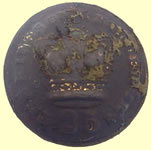 |
 |
 |
|
Victorian 25th Regiment of foot button Kings own royal border regiment |
20thC shipping line badge | Georgian button | |
 |
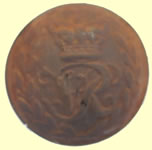 |
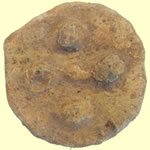 |
 |
| Post medieval spur rowel | Victorian Royal Engineers button | 15thC lead token | Medieval buckle plate |
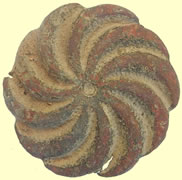 |
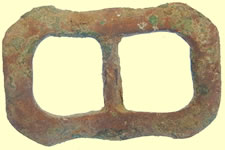 |
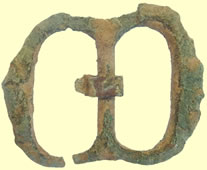 |
 |
| 1500-1700 mount | 1550 - 1650 buckle | 1500-1650 buckle | 17thC lead token |
 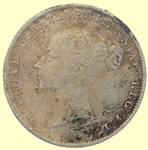 |
 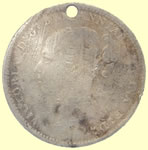 |
||
| 1844 Victoria milled silver sixpence | 1885 Victoria milled silver three pence | ||
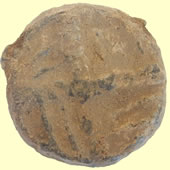 |
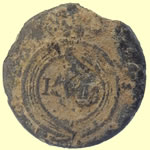 |
 |
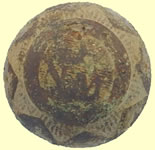 |
| Medieval lead token | Unknown early military button | 1500-1700 mount | Unknown military button |
1500-1200 BC Late Bronze Age arrow head |
|||
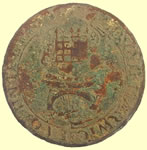 |
 |
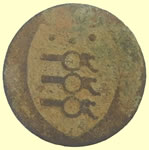 |
|
| Rare find 19thC Harwich Loyal Volunteers army button
Napoleonic period |
19thC Norwich Union Society Insurance company button |
18thC Royal Artillery button | |
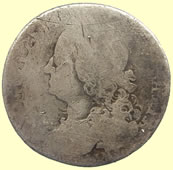 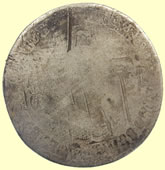 |
 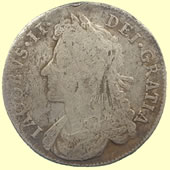 |
||
| 1730 George II milled silver shilling | 1685 James II milled silver shilling | ||
Stunning 11thC late Viking buckle - two biting beasts gripping the cross bar of the buckle |
|||
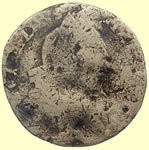 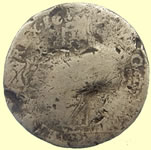 |
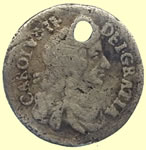 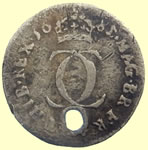 |
||
| 1696 William III milled silver sixpence | 1685 Charles II milled silver two pence | ||
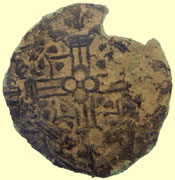 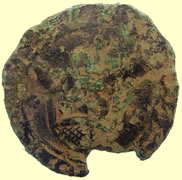 |
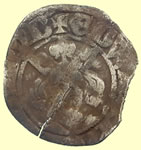 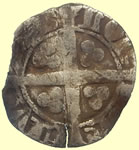 |
||
French Jetton Crown introduced in 1340 by Philip VI (1328-50) Royal Crown with 3 rosettes across body of crown Rev Triple banded straight cross fleuretty AV |
1279 Edward 1st hammered silver penny Obv + EDWA**** hYB Rev CIVI/TAS/LON/DON - London mint |
||
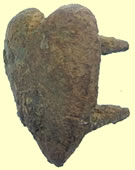 |
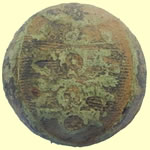 |
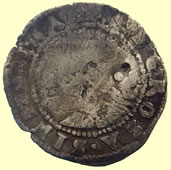 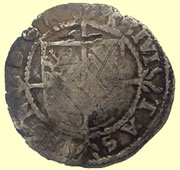 |
|
| 1500 -1700 mount | 18thC Royal Artillery button | 1582 -1584 Elizabeth 1st hammered silver half groat - A mint mark | |
|
|||
| Part of 1st to 4thC Roman bronze and silver hoard reported to museum as potential treasure | |||
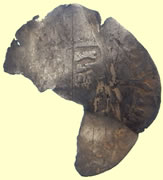 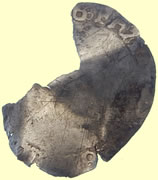 |
 |
 |
|
| 1554 Mary hammered silver groat | WWII Royal tank regiment button | 1500-1700 mount | |
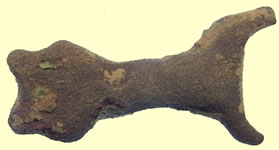 |
 |
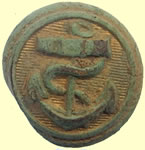 |
|
| 10thC Saxon harness cheek piece | Britain's Merchant Navy Bliss Bros Ltd Rd 665050 |
1900's Generic merchant navy button | |
  |
 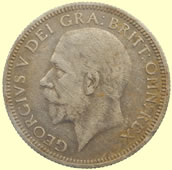 |
||
| 1767 Dutch Over Ysell copper coin | 1928 George V milled silver shilling | ||
 |
 |
 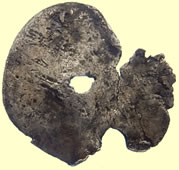 |
|
Royal Artillery button Dates - 1840 - 1855 |
Medieval bronze thimble | 1625 Charles II hammered silver half groat | |
 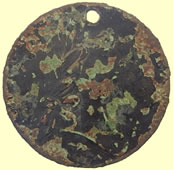 |
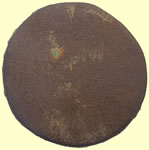  |
||
| 18thC George III gold half guinea gaming token | 1770's George III gold half guinea coin weight 2 pennyweight and 16 grains |
||
  |
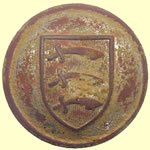 |
||
| 1856 Victoria milled silver sixpence | Essex county button | ||
 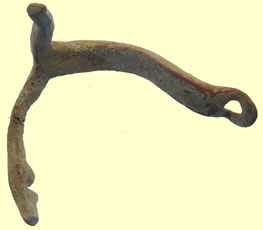 |
|||
| Medieval copper suspension bar, reminds me of a basic balance scales | |||
 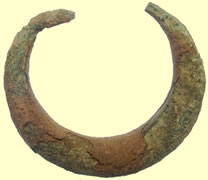 |
 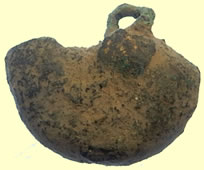 |
||
| Roman pugio suspension ring | Romano/British bronze gilded pendant - suspension loop remains | ||
 |
 |
 |
|
| Georgian silver spoon handle | 17thC clothing fastener | 20thC British Rail button | |
Georgian silver spoon |
|||
 |
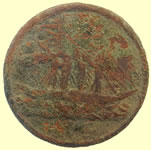 |
 |
 |
| 15thC lead token | 19thC sailing button | RN Capt / Commander - 1787 RN Lieutenant - 1787 |
Royal Artillery button Dates - 1840 - 1855 |
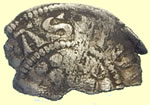 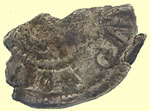 |
  |
||
1247 Henry III hammered silver voided long cross half penny Rev TAS/LON - London mint |
Oct 1470-April 1471 Henry VI hammered silver penny (2nd reign) - initial mark Lis G and Key to side of neck - quatrefoil in centre of reverse cross - York mint |
||
  |
 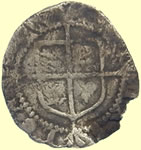 |
||
| 1247 Henry III hammered silver voided long cross half penny | 16thC Elizabeth 1st hammered silver penny | ||
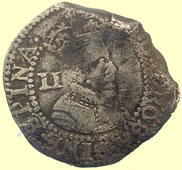  |
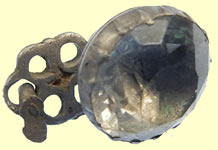 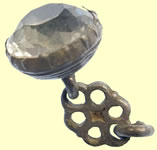 |
||
| 1603 James 1st hammered silver half groat | Georgian silver cuff-link with glass stone | ||
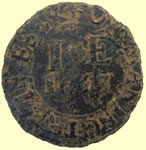 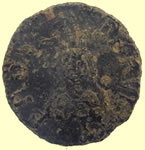 |
 |
 |
|
1653 Jeremy Erds of Manningtree Essex hammered copper trade farthing |
15thC lead token - type 2 | 19thC livery button | |
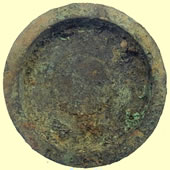 |
 |
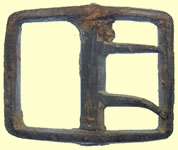 |
 |
| Victorian trade weight | AA GB | 19thC buckle | 16thC Tudor button |
  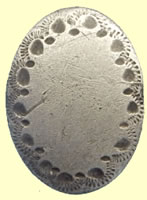 |
|||
|
HB in script First recorded English woman silversmith London Assay office Hester Bateman is without doubt the most popular and renowned of all women silversmiths. Yet Hester's career as a silversmith was never intended. Widowed at the age of 51, she inherited her husband's small workshop practice and for the next thirty years, this unlikely shrewd business woman, grew the workshop into a thriving silver manufacturing firm. Hester Bateman was born in 1704 in Clerkenwell, London (England), and married John Bateman (a goldsmith) in about 1725. They had six children; John, Letticia, Ann, Peter, William, and Jonathan. The family lived at 107 Bunhill Row in the Parish of St. Luke in North London for more than a century. John and Hester purchased the houses on both sides of theirs, and two of the children occupied those homes in later years. Although his sons Peter & Jonathan were both doing their silversmithing apprenticeships, when John Bateman died in 1760, he bequeathed all his tools to Hester suggesting that she was already an accomplished silversmith. However, even with the skills of the trade, Hester had no small task ahead of her to continue the business. In these times, women-owned businesses were generally not accepted, and the industry was highly competitive. Unperturbed, Hester registered her mark of a scroll HB at Goldsmiths Hall in 1761 and aided by her son's Peter and Jonathan along with Jonathan's wife, Ann, the business boomed. In 1790, Hester finally retired at the grand old age of 81. Sadly, the following year her son Jonathan died, leaving Peter without his two long term partners. He turned immediately to his sister in law Ann, making her a partner in the business and registering their joint mark in 1791. From then Ann became the driving force in the business until her retirement in 1805. In 1800, Jonathan and Ann's son, William, became a partner in the family business, completing possibly the most famous of all silversmithing dynasties. Unlike most silversmiths who specialised in just one area of production, the Batemans were masters of many, producing fine wares right across the board. The main reason for their success was due to Hester's attention to design, detail and quality. All the pieces that left the workshop would be inspected to the highest standard and with this attitude the business grew. Many pieces of Hester Bateman's silver show identifying characteristics such as bead detailed edges and fine designs of bright-cut engraving. They received many commissions from The City Guilds, various religious establishments, and private individuals
|
|||
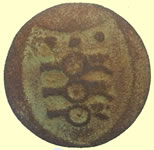 |
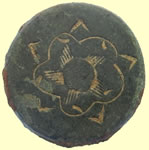 |
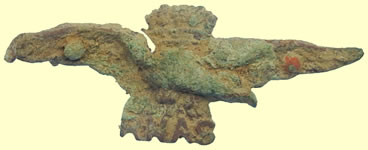 |
|
| 18thC Royal artillery button | Royal Navy Lieutenant - 1748 RN Flag Officer - 1748 |
Royal Naval Air Service (RNAS) was the air arm of the Royal Navy, under the direction of the Admiralty's Air Department, and existed formally from 1 July 1914 to 1 April 1918 | |
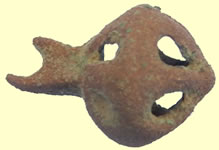 |
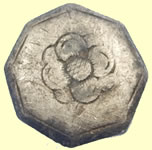 |
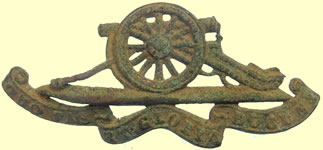 |
|
| 16thC Tudor button | 18thC Royal navy silver button | WWI Royal artillery cap badge | |
 |
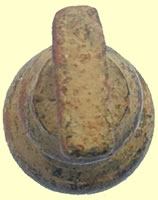 |
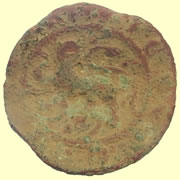 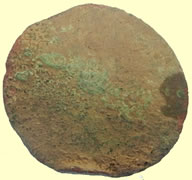 |
|
| Georgian bell trade weight | Crude 18thC German Jetton Lion of St Mark standing left with both wings shown. Book of the Gospels between fore- paws.Halo, rising into the margin, is surrounded by a star: |
||
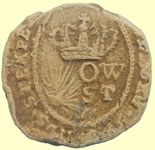 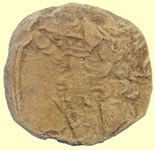 |
 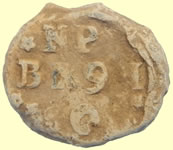 |
||
| Post medieval lead bale seal | 1763 Russian lead bale seal | ||
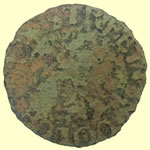 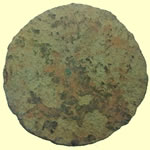 |
 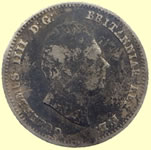 |
||
| 17th Street of Colchester Essex hammered copper trade farthing | 1836 William IV milled silver four pence | ||
 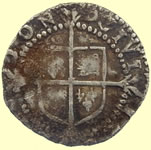 |
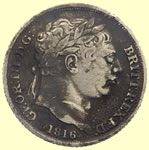 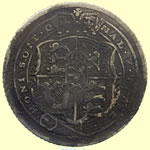 |
||
| 1590 - 92 Elizabeth 1st hammered silver penny - hand mint mark | 1816 George III milled silver sixpence | ||
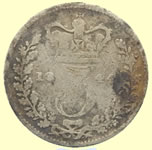 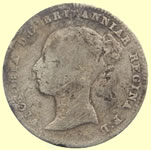 |
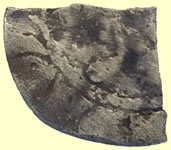 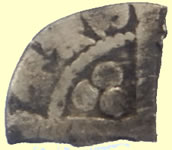 |
||
| 1844 Victoria milled silver three pence | 1247 Henry III hammered silver voided long cross farthing | ||
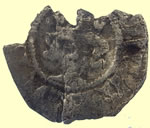  |
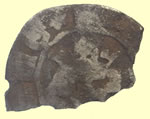  |
||
Medieval hammered silver half penny Rev LON/CIVI - London mint |
Medieval hammered silver half penny | ||
 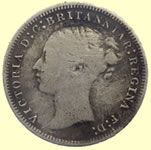 |
 |
 |
|
| 1874 Victoria milled silver three pence | Georgian spur buckle fitting | 18thC clog fastener | |
|
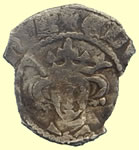 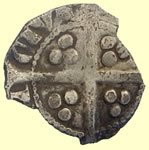 |
||
| Georgian silver decorated mount | 1279 Edward 1st hammered silver penny - Class 9 star on breast Obv hYB+EDW |
||
 |
 |
||
A copper-alloy sexfoil mount of Medieval date. The mount has been stamped from a piece of sheet-metal. It has six convex petals separated by grooves which cross at the centre. The underside is hollow and there is a possible corroded rivet attachment at the middle. Several examples of sexfoil mounts have been found in excavations in London (see Egan and Pritchard 1991: 186-193). Class: Sexfoil ChronologyBroad period: MEDIEVAL Materials and constructionPrimary material: Copper alloy Manufacture method: Stamped |
A copper-alloy cast mount. The mount is quatrefoil in shape with a cusp in each angle. ChronologyBroad period: POST MEDIEVAL |
||
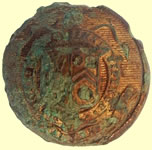 |
 |
 |
|
| 19thC corporation button | 19thC 53rd regiment of foot button The 53rd (Shropshire) Regiment of Foot |
Lots of George V and VI milled silver sixpences turning up | |
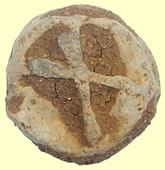 |
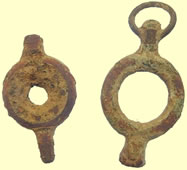 |
 |
 |
| Medieval lead trade weight | Georgian watch winders | 1500-1700 mount | 1500- 1700 buckle |
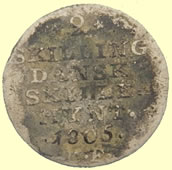 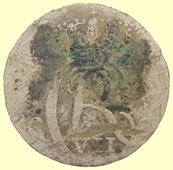 |
 |
||
| 1805 Denmark 2 skilling milled silver billion coin | 18thC clog fastener | ||
1422- 27 Henry VI hammered silver groat - Annulet issue - Annulets by neck and two sets of oppossing pellets on reverse - Incorrect spelling of Calsie - IE missing, Obv legend should end in Z FRANC ?? Obv hENRIC DI GRA REX ANGLIE Z B ?? Rev VILLAx CALISx - Calais mint |
|||
Great shape 4thC Roman silver washed coin - sent for ID 1.84g, 18.84mm Could I please have an average diameter and approximate weight? Carausius issued a few coins in the names of the Tetrarchs with whom he wished to be identified - and I haven't gotten that far yet, but I'll let you know if I find something. Very interesting. Mark This turns out not to be so oddball as I originally thought - because my initial guess was off by about 60 years - This is Maximinus I, 235-238 ("Thrax", "The Giant", "The Goth", etc. it's assumed he suffered from acromegaly) and if, as I'm guessing, it turns out to be in the 22-25mm vicinity, it would be an As. If it's larger, then it's more likely to be a Sestertius. It was obviously wrong for Maximinus II Daia, and I kept trying to find some issue of Maximian - perhaps a post abdication issue - instead. This denomination, quite rare, but not unknown during his time was still not listed with any standing Providentia reverses. You have very seldom found - or at least showed me - coins of this general era. I find it somewhat surprising, since both earlier and later Roman coins seem to be represented in profusion. Was there some sort of disaster, plague or other external force which depressed the Roman settlement and/or population in the Colchester area around the early-mid 3rd century? Mark PS - I should give you a reference - if an As, it's RIC IV 63, Mint of Rome & SRCV 8362. At that size and weight - and missing the S - C (which I somehow thought I was seeing) this is actually a denarius. It should be silver, but if it's demonstrably Æ, then it's probably what is erroneously called a "Limes Denarius" - these were high-quality copies made primarily in the Balkans and central Europe by making molds in clay using official coins. These are often found silvered - and often found with all traces of silver (if there ever was any) missing. No one is quite sure where these fit into the monetary picture of the times, but they exist in great numbers - so great that they must have been in circulation. Change those references to: RIC IV 13; RSC 77; SRCV 8315. That would be for the prototype denarius from which it was copied. If it's Æ - and it seems awfully light for silver - then it's a contemporary copy made in the so-called "Limes Denarius" tradition. Mark
|
|||
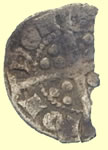 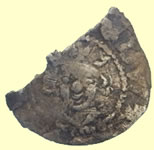 |
 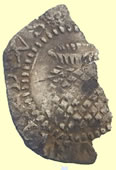 |
||
1279 Edward 1st hammered silver half penny - inner circles both sides Obv EDWARDVS *** Rev LON/DON - London mint |
1603 James 1st hammered silver half groat | ||
1490 - 1500 Henry VII hammered silver half groat - two arches jewelled - no lis to 7 tressures, Tun mint mark King and Archbishop Morton jointly - no stops Obv hENRIC DI *** ANGL ZF Rev CIVI/TAS/CAN/TOR - Canterbury mint |
|||
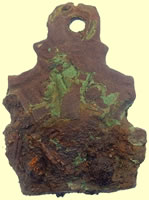 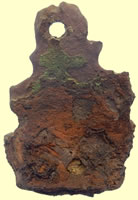 |
 |
||
| c10th Saxon stirrup mount - Type 9 human mask type | Royal Army ordnance Corp badge | ||
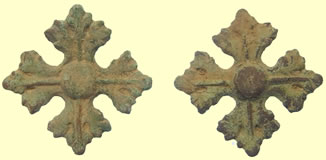 |
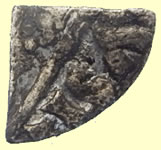 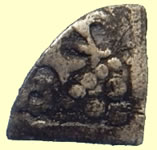 |
||
| Medieval mounts | 1247 Henry III hammered silver voided long cross farthing Rev/OND/ - Durham mint |
||
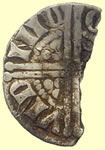 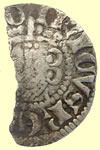 |
 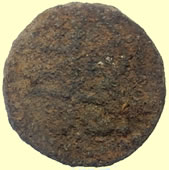 |
||
1247 Henry III hammered silver voided long cross penny Rev VCD/NIC/O ** Moneyer Nicole of London mint |
Unknown copper coin - needs clean to reveal detail - possible Asian | ||
 |
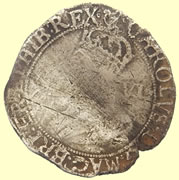 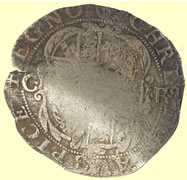 |
||
| 20th Alloy Navy badge | Irish Charles 1st hammered silver sixpence - Harp mint mark | ||
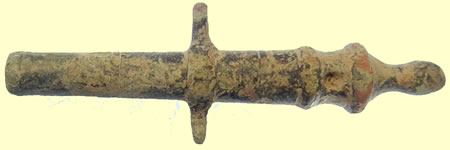 |
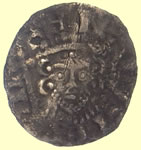 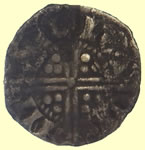 |
||
| Large 18thC toy cannon | 1247 Henry III hammered silver voided long cross penny Obv hENRICVS REX III |
||
Stunning 14thC enamelled harness pendant |
|||
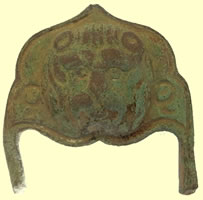 |
 |
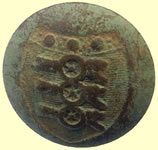 |
|
| Victorian lion headed belt buckle | 18thC musket ram rod guide | 18thC Royal artillery button | |
 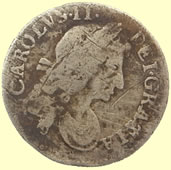 |
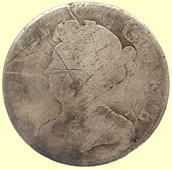 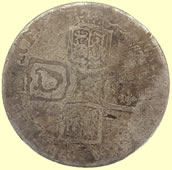 |
||
| 1680 Charles II milled silver three pence | 1709 Queen Anne milled silver shilling | ||
  |
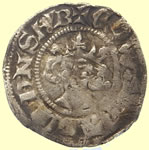 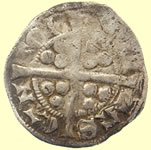 |
||
1702- 14 Queen Anne milled silver shilling Exeter mint |
1300- 1310 Edward 1st hammered silver penny - Class 10 Obv +EDWAR ANGLE DNS hYB Rev CIVI/TAS/CAN/TOR - Canterbury mint |
||
1846 Victoria milled gold half sovereign 19.38mm, 4.02g |
|||
c10thC Stunning gilded and decorated Saxon brooch fragment |
|||
 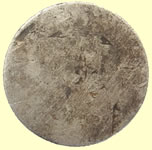 |
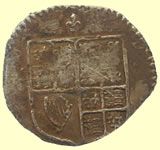 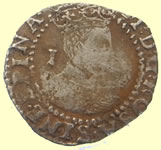 |
||
| 1818 George III milled silver sixpence | 1623- 4 James 1st hammered silver penny - Lis mint mark | ||
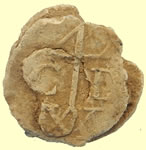 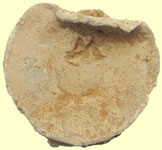 |
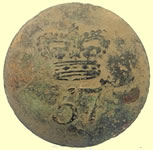 |
||
| Post medieval cloth seal |
19thC - 57th (West Middlesex) Regiment of Foot button The regiment started out as the 59th Regiment of Foot raised in Gloucester in 1755. After the disbandment of the 50th Regiment of Foot and the 51st Regiment of Foot in 1756, it became the 57th Regiment of Foot. In 1782, it was given a county connection, becoming the "57th (the West Middlesex) Regiment of Foot". The 57th Regiment earned their nickname of "the Die Hards" after their participation in the Battle of Albuera, one of the bloodiest battles of the Peninsular War, fought on 16 May 1811 |
||
 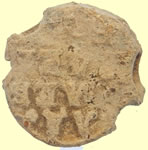 |
 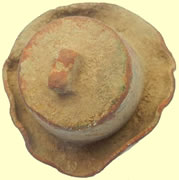 |
||
| 1827 Russian lead bale seal | Georgian horse harness bell | ||
More 2016 finds pages Previous 2016 Feb finds pageNew 2016 March finds page II |
|||
 |
|||
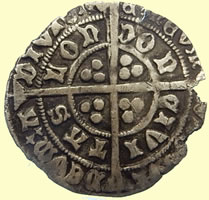
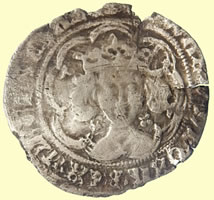

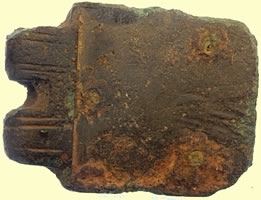


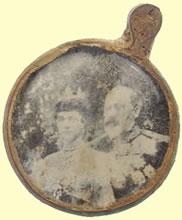
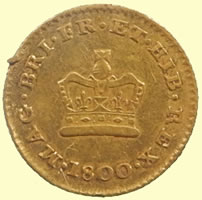
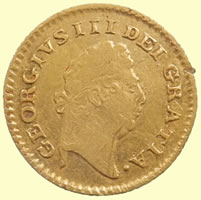


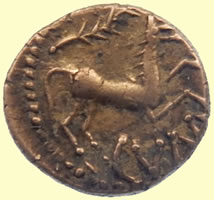

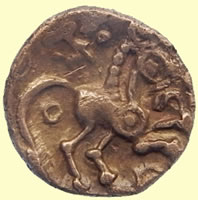
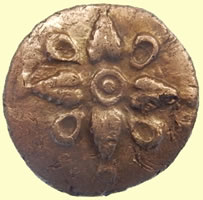

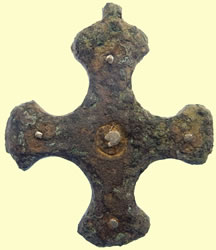
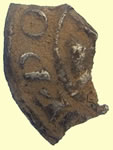
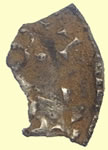


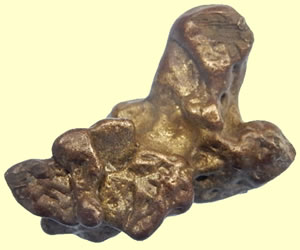
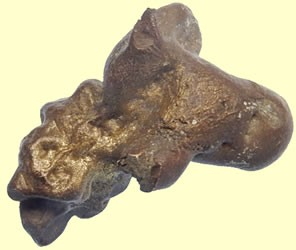
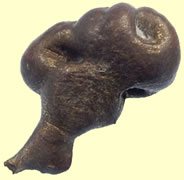
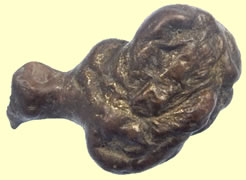
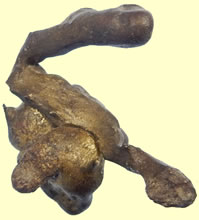
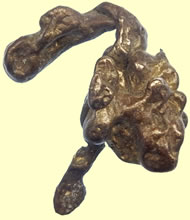

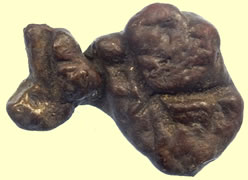
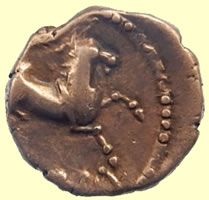
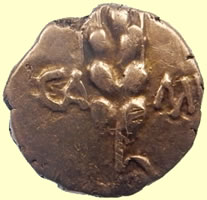
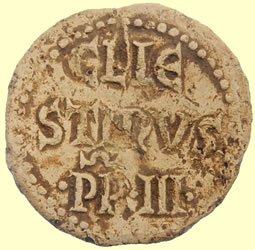
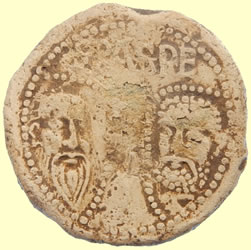
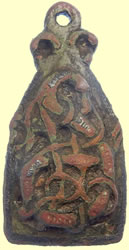


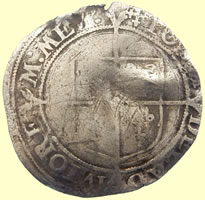
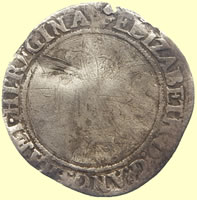
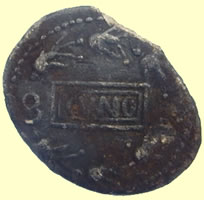
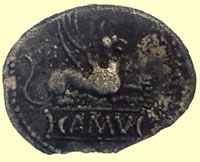
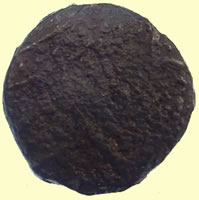
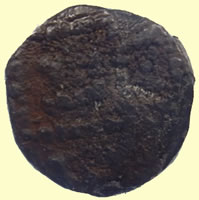

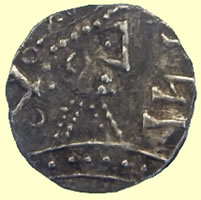
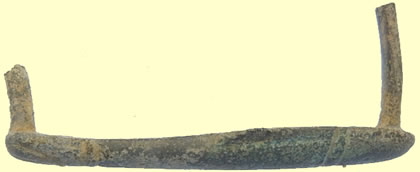

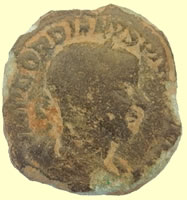

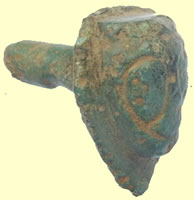

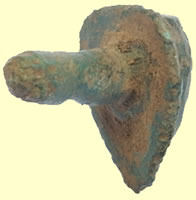
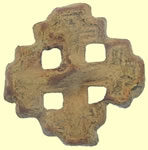
 'A badge for a Knight of the Order of the Holy Sepulchre in bronze and dating somewhere around C13/14th possibly very slightly later . This is a very scarce item and it relates to The Equestrian Order of the Holy Sepulchre of Jerusalem being a Catholic chivalric order of Knighthood that traces its roots to Godfrey of Bouillon, principal leader of the First Crusade. According to reliable sources in the Vatican and Jerusalem, it began in historical reality as a mixed clerical and lay confraternity (association) of pilgrims which gradually grew around the most central of the Christian holy places in the Middle East, the Holy Sepulchre or the tomb of Jesus Christ.This would have been a pin for a member of the order , there is a mark on the reverse where the original pin would have been fixed '
'A badge for a Knight of the Order of the Holy Sepulchre in bronze and dating somewhere around C13/14th possibly very slightly later . This is a very scarce item and it relates to The Equestrian Order of the Holy Sepulchre of Jerusalem being a Catholic chivalric order of Knighthood that traces its roots to Godfrey of Bouillon, principal leader of the First Crusade. According to reliable sources in the Vatican and Jerusalem, it began in historical reality as a mixed clerical and lay confraternity (association) of pilgrims which gradually grew around the most central of the Christian holy places in the Middle East, the Holy Sepulchre or the tomb of Jesus Christ.This would have been a pin for a member of the order , there is a mark on the reverse where the original pin would have been fixed '

